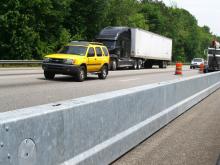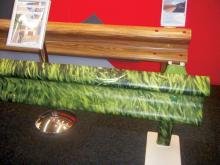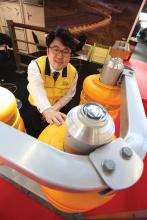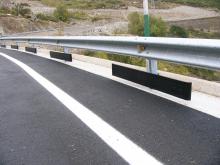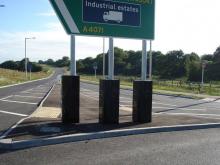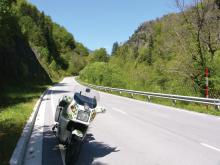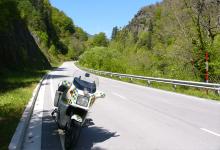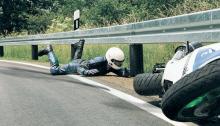Novel safety barrier solutions are coming to market, writes Mike Woof The safety barrier market is a focus for innovative products designed to meet a range of different applications. The diverse range of vehicle types on the road poses numerous technical challenges to barrier manufacturers. At the same time, different applications such as motorcycle safety, end treatments, bridge barriers and roadside obstacle protection require novel solutions. Although motorcycles account for only a small proportion of ve
Proper protection of workzone areas can boost protection for highway workers with conspicuity being one issue, although speeding and physical separation of personnel from vehicles also need to be addressed
Novel safety barrier solutions are coming to market, writes Mike Woof
The safety barrier market is a focus for innovative products designed to meet a range of different applications. The diverse range of vehicle types on the road poses numerous technical challenges to barrier manufacturers. At the same time, different applications such as motorcycle safety, end treatments, bridge barriers and roadside obstacle protection require novel solutions.Although motorcycles account for only a small proportion of vehicles on the roads, they feature a high risk factor for riders. Accident data in Europe shows that most motorcycle accidents are not the fault of the rider, with other road users being the highest cause of accidents. However motorcyclists also suffer injuries and fatalities from roads that have been designed around road users in passenger cars, buses or trucks. A notable issue is with many conventional safety barriers as these are designed to protect road users sitting inside a vehicle. Work is being carried out on tackling this problem, but progress is only being made slowly at a pan-European level.
The French test laboratory
However delays to the introduction of this new specification have arisen from extended discussions over technical parameters. The Federation of European Motorcycle Associations (
Ironically, much of the technology needed already exists. Because of the more far-sighted approach to safety by the Spanish authorities, a range of systems have already been developed to help protect motorcyclists with new products also coming to market. One of the latest is a new steel motorcycle safe barrier product from
Other firms with existing products intended to boost barrier safety for motorcycle riders include
Safety technology is at a much greater state of development for more conventional vehicle occupant protection measures, with some truly innovative designs having been produced. One of the most original concepts comes from South Korean supplier
Modular design can help reduce costs to the install in conventional roadside barriers and this is a feature
In the end treatment sector,
On the US market version, the cables help redirect the vehicle but on the new European model developed by Snoline, the cables are used to absorb the impact forces. With the US vehicle fleet including a much higher proportion of SUVs that are heavier and have a higher centre of gravity than the smaller, lower and lighter passenger cars that predominate on European roads, barrier designs and specifications have been tuned to meet vehicle trends. Chiara Luini, director of marketing at Snoline explained that to meet the European requirements the unit now has an additional cable retention feature. Steel guides are used to hold the cables in place and she added, "Redirection is made by the lateral barrier." She said that while the concept of this barrier is comparatively simple it offers an effective safety solution. "We are going to test it in the next few months but we've already carried out computer simulations and the results are good," she said, adding that full European approval is expected in the next few months.
Other new end treatments are also being introduced by rival firms.
And Marcegaglia has developed the improved P4 improved energy absorbing terminal and this has been designed for easy installation. This is available in H2, H3 or H4 ratings and is based on a modular design approach using common components but different posts depending on the impact rating required.
Bridge barriers offer further challenges and a high performance system is now coming to market from Spanish specialist Industrias Duero. The H3 rated bridge parapet structure has been designed to cope with impacts from large trucks and coaches as well as passenger cars and meets the relevant EN1317 specification in this category. Twin innovations allow the novel two part barrier to be used to boost safety in an array of bridge applications and installations.
Area manager Zoubeida Foughali explained that one development is the use of bolts designed to absorb some of the forces when a large vehicle impacts with the structure and to then shear off, without damaging the bridge. She said, "The forces are not transferred to the concrete structure. The bridge has reduced maintenance needs in case of an accident as you only need to change the bolts and the two part barrier." According to international manager for the firm Fernando Montesinos this specification is of particular importance for the Spanish, Portuguese and French markets where there is a requirement to minimise damage to a bridge structure in the event of an impact. He explained that where repairs are carried, they will never be as strong as the original structure so these countries have established a specification intended to minimise damage and prevent any weakening.
While able to withstand impacts from large vehicles such as trucks and coaches, this two part barrier also features a lower rail designed for passenger vehicle retention. The lower rail projects forward slightly from the two upper rails and features a spacer designed to absorb the impact from lighter passenger cars, while the two upper rails are set back and retain heavy vehicles.
Temporary barriers have to be used on some sections of road, whether to delineate workzone areas, road closures or special events for example. A novel temporary barrier system has been developed by Spanish firm
The units are hinged and can be folded open for stacking or closed and locked in place for use at the roadside. Once in place the sections can be filled with either sand or water to make them more stable. The barrier units are offered in red or white plastic as standard although other colours are available on request.
Border Barrier Systems is continuing to develop the market for its Rhino water-filled barrier units, with the standard products tested to vehicle impacts of 50km/h and the high specification units tested to 80km/h. All of the Border Barrier Systems units are made from plastic, making them lighter and easier to transport than conventional steel or concrete units, as well as increasing safety in a range of applications. The company also points out that its various units can also be interlinked where necessary between different model types. Meanwhile the new Klik Panel sections can be fitted on top of the new self-weighted units as well as the proven Rhino barriers. The Klik Panel units can be used to screen off construction sites and are lighter and more resistant to damage than conventional steel sheets. Because the Rhino barriers are so much lighter than conventional products, this reduces transport and handling costs considerably and also increases safety when handling on-site.
Meanwhile Snoline now offers a temporary roundabout called the Giro, which comes in polyurethane sections and is suitable for use in roadworks or diversions. And Snoline also has a novel crash cushion product made from plastic that can be placed around roadside obstacles such as trees in noted danger spots, reducing impact forces in the event of an accident.

